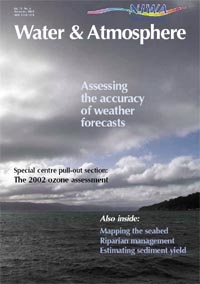PDF of this article (80 KB)

Murray Hicks Ude Shankar Alistair McKerchar
A GIS layer is now available for estimating long-term average suspended sediment yields from catchments throughout New Zealand.
How much sediment is a certain river or stream likely to carry over an average year? This information can be useful for a variety of issues. For example, planners might need to know how fast sediment might accumulate in a potential reservoir, or how vulnerable estuarine and coastal marine habitats are to sediment inputs from the land.
New Zealand-wide information is now available to help in cases like these. It is in the form of a geographic information system (GIS) layer of specific suspended sediment yield, or SSY, given in tonnes of sediment per square kilometre of catchment area per year (t/km2/y). The layer (see map below) can be used to estimate the amount of sediment delivered from within any defined catchment boundary. So far, we have used the layer to estimate the suspended sediment yields to the coast from major rivers as well as the total yield to the New Zealand coast.
Getting the information
We obtained the information to build up the GIS layer from two sources.
First, the amount of sediment carried in rivers and streams was measured at over 200 river-gauging stations throughout the country.
Second, we used these measurements to calibrate a model that predicts suspended sediment yields from the rest of the country. The model relates SSY to mean annual rainfall and a so-called “erosion terrain” classification. Different erosion terrains were assigned according to how easily land is eroded. The terrains – defined by scientists from Landcare Research – were based on data on slope, rock-type, soils and dominant erosion processes, along with some expert knowledge. We calibrated the model by adjusting the predicted sediment yields to match the measured values at the 200 gauging stations. Therefore this is an empirical model – in other words, it is based on measured data.
How much sediment reaches our coasts?

We have used the GIS layer to estimate how much sediment is washed out to the New Zealand coast each year, and where it comes from. The total estimated – 209 million tonnes per year (Mt/y) – is approximately evenly split between North and South Islands (91 and 118 Mt/y, respectively).
The highest yields from the North Island are to East Cape. It’s easy to see why erosion is so high here. Rainfall is moderately high. The mudstone and sheared argillite rocks are easily eroded. The area is prone to earthquakes, which tend to expose broken rock. Finally, the native forest cover is almost completely removed. These factors combine to give specific suspended sediment yields of up to 20,000 t/km2/y. This amounts to an average lowering of the land surface in the region by approximately 7.5 mm each year. The East Cape region is 6% of the area of North Island, but accounts for 58% of the sediment yield. The Waiapu River alone delivers 35 Mt/y. In contrast, the relatively low-relief areas of the northeastern North Island generate comparatively little sediment (for example, only 0.35 Mt/y is delivered to the Hauraki Gulf).
In the South Island, the highest SSYs are from the western flanks of the Southern Alps in south Westland. There, a combination of steep slopes, heavy rainfall, high uplift rates along the eastern side of the Alpine Fault, and easily eroded schist result in specific yields up to 32,000 t/km2/y. The regional yield is 62 Mt/y. This represents 68% of the South Island yield from just 8% of the land area.
In contrast, and despite heavy rainfall, sediment yields in Fiordland are only 1.3 Mt/y. This reflects the hard, glacier-scoured, gneiss rock, and almost complete forest cover below the tree line.
Sediment trapped in lakes
Lakes trap sediment that would otherwise be washed out to sea. Estimates from the GIS layer indicate that the large natural lakes of the South Island trap some 15 Mt/y of suspended sediment, while natural lakes in the North Island trap less than 1 Mt/y. So how much difference have man-made hydro-lakes made to the sediment yield to the coast? Well, hydro-lakes in the South Island’s Clutha and Waitaki catchments intercept 2.4 Mt/y, while dams on the Waikato and Rangitaiki Rivers trap some 0.4 Mt/y. In total, natural lakes trap 15% of the potential sediment delivery to the New Zealand coast, while hydro-dams have reduced the natural suspended sediment yield to the coast by 1.3%.
Teachers: this article can be used for NCEA Achievement Standards in Geography (3.1), Agricultural/Horticultural Science (1.3, 1.5). See other curriculum connections at www.niwa.co.nz/pubs/wa/resources
Murray Hicks, Ude Shankar and Alistair McKerchar are based at NIWA in Christchurch.
This study was partly supported by the Foundation for Research, Science and Technology under Contract C01X0024.
For further information, contact Murray Hicks ([email protected]) or Ude Shankar ([email protected]).
